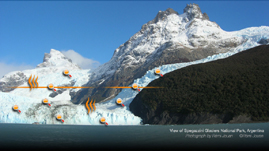Teachers' Domain - Digital Media for the Classroom and Professional Development
User: Preview

Source: ThinkTV
Glaciers around the world have been shrinking in size during the past century. Some small glaciers at high altitudes will disappear in the coming years. To measure whether a glacier is growing or shrinking, scientists measure its volume or mass. The mass of any glacier is in an ever-changing balance known as its glacial mass balance. Glacial mass balance is the relationship between the rate of snow accumulation on a glacier and its rate of loss of snow and ice, usually measured over one year. Making measurements of glacial mass is challenging because of glaciers' faraway locations. Scientists use a variety of techniques such as GPS or satellite mapping, aerial photography, and airborne radar and laser mapping.
Researchers have specific terms for gains and losses of glacial snow and ice mass. They use the term accumulation to refer to snowfall gain. Ablation is the term that describes any process by which the glacier decreases in mass. Accumulation and ablation occur in different zones along a glacier. The zone of accumulation is the area of the glacier that receives more snow than it loses during a year. The zone of ablation is the area of the glacier that loses more ice and snow than is replaced by new snowfall during a year.
The zone of accumulation and the zone of ablation are not fixed places on a glacier, but can move up and down its length. The place on the glacier where the rate of accumulation equals the rate of ablation is called the line of equilibrium.
Ablation occurs in four ways. Melting is when snow and ice melt or change from a solid phase into a liquid phase and run off the glacier. The rate at which glaciers worldwide are melting appears to be increasing. Evaporation occurs when melting snow turns into water puddles that then vaporize into a gas. Sublimation occurs when snow and ice change directly into a gas state, particularly under conditions of low humidity and low air pressure. A common example of sublimation is the carbon dioxide gas given off by a chunk of dry ice. The last way glaciers lose mass is through calving, when chunks of ice break off the glacier into the area below. This takes place at the lowest end, or terminus, of the glacier.
Scientists have learned that glaciers are a sensitive indicator of climate conditions. They are paying great attention to whether particular glaciers are growing or shrinking annually.
Here are suggested ways to engage students with this interactive feature and with activities related to this topic.
 Loading Standards
Loading Standards